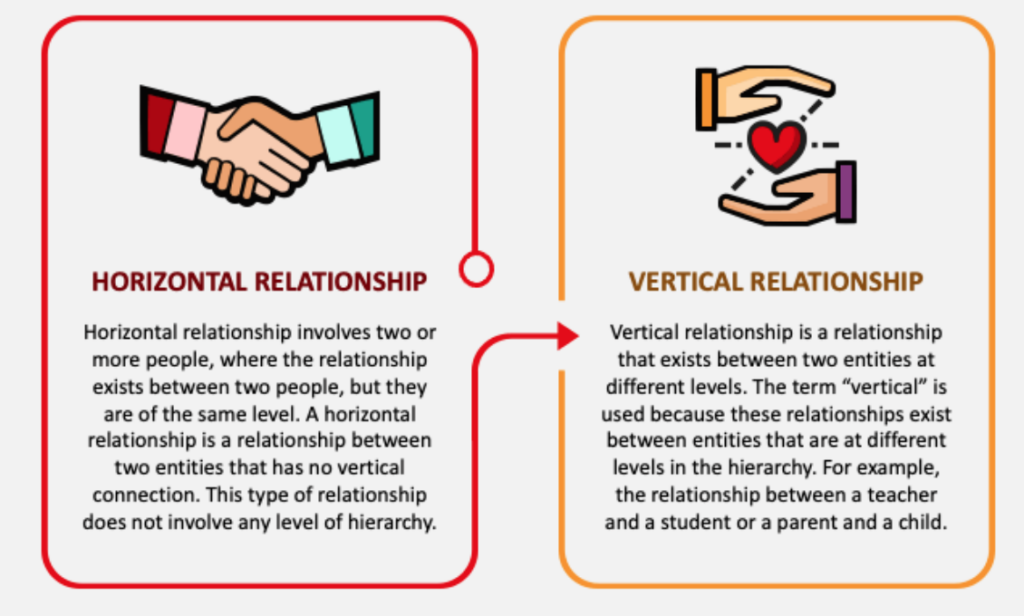Discover the key differences between horizontal and vertical relationships. Learn how power dynamics, communication styles, decision-making processes, and conflict resolution vary between these two types of relationships.
Whether in personal friendships, partnerships, or workplace hierarchies, understanding these distinctions can help improve interactions and foster better relationships. Explore examples of horizontal relationships, which emphasize equality and collaboration, and vertical relationships, where authority and structure dominate. This guide provides valuable insights to help you navigate both professional and personal relationships more effectively.

What Are the Differences Between Horizontal and Vertical Relationships?
Relationships, whether personal or professional, can often be categorized into two types: horizontal and vertical. Understanding the differences between these two relationship structures is crucial in various contexts, from family dynamics to workplace hierarchies. In this article, we will explore the key distinctions between horizontal and vertical relationships, their characteristics, and how they influence interactions and dynamics within groups or individuals.
Horizontal Relationships
Horizontal relationships refer to interactions where individuals or groups are on an equal level. There is no inherent power imbalance, and everyone involved has an equal say or responsibility in the relationship. These relationships are typically based on mutual respect, collaboration, and equality.
Characteristics of Horizontal Relationships
- Equality: All parties are on the same level, with no one holding more power or authority over the other.
- Mutual respect: Interactions are often collaborative, with all parties valuing each other’s opinions and inputs equally.
- Shared responsibility: Decisions and responsibilities are shared equally among the participants.
- Peer-based: Horizontal relationships are commonly found between peers, such as colleagues or friends.
Horizontal relationships are common in friendships, partnerships, and teams where individuals work together without a hierarchical structure. In these relationships, communication tends to be open, and conflicts are resolved through negotiation and compromise, rather than command and control.
Examples of Horizontal Relationships
- Friendships between individuals who treat each other as equals.
- Collaborative teams at work where decision-making is shared.
- Marriage or partnership where both individuals share responsibilities equally.
Vertical Relationships
Vertical relationships, in contrast, are characterized by a hierarchy where one party holds more power, authority, or responsibility than the other. These relationships often involve a clear leader or dominant figure and a subordinate or follower. Vertical relationships are based on a top-down approach to authority and decision-making.
Characteristics of Vertical Relationships
- Power hierarchy: One person or group holds a position of authority over the other, with defined roles for leader and follower.
- Unequal influence: Decisions and responsibilities are primarily managed by the individual in a higher position of authority.
- Control: The dominant party often directs and controls the actions of the subordinate, determining how tasks are performed or how the relationship evolves.
- Structured interactions: Communication and decision-making often follow a formal structure, especially in professional settings like employer-employee relationships.
Vertical relationships are commonly seen in workplaces, educational settings, and sometimes in family structures, where authority is clearly defined, and individuals have specific roles to play. Communication in vertical relationships is typically more formal, and instructions or decisions tend to flow from the top down.
Examples of Vertical Relationships
- Manager and employee relationships, where the manager gives instructions and the employee follows.
- Teacher and student relationships, where the teacher holds authority over the student.
- Parent and child relationships, especially in traditional settings where parents have authority over children.
Key Differences Between Horizontal and Vertical Relationships
- Power Dynamics: In horizontal relationships, power is equally distributed, while in vertical relationships, one party holds more authority than the other.
- Decision-Making: Decision-making in horizontal relationships is shared, whereas, in vertical relationships, decisions are often made by the dominant party.
- Communication Style: Communication in horizontal relationships is typically open and collaborative, while in vertical relationships, communication is often directive and one-way.
- Conflict Resolution: Conflicts in horizontal relationships are resolved through discussion and compromise, whereas in vertical relationships, the dominant party often has the final say in resolving conflicts.
Conclusion
Understanding the differences between horizontal and vertical relationships can help in navigating both personal and professional dynamics. Horizontal relationships foster collaboration and equality, while vertical relationships are more structured with clear hierarchies of authority. Both types of relationships have their place and are beneficial depending on the context in which they occur. By recognizing the type of relationship you are in, you can improve your interactions and foster healthier, more effective communication with others.
